By TREVOR HOGG
Images courtesy of Columbia Pictures/Sony.
By TREVOR HOGG
Images courtesy of Columbia Pictures/Sony.

An unarmed Ladybug (Brad Pitt) has to improvise while fighting the knife-wielding Wolf (Bad Bunny).
Assassins have been mixing with stunt coordinator and second unit director turned filmmaker David Leitch (Atomic Blonde) ever since he launched the John Wick franchise with colleague Chad Stahelski; however Bullet Train marks a departure for him. “All of my work in the action genre has been focused around a single protagonist whereas Bullet Train is an ensemble that has a lot of characters to keep track of and an arc within the twisting narrative,” Leitch states. The satirical thriller is based on the novel Maria Beetle by Kōtarō Isaka where trained killer Ladybug (Brad Pitt) does one last job onboard a bullet train traveling from Tokyo to Kyoto, and in the process of doing so has to contend with other professionals like himself. The cast of Brad Pitt, Joey King, Aaron Taylor-Johnson, Brian Tyree Henry, Zazie Beetz, Sandra Bullock, Karen Fukuhara, Michael Shannon, Hiroyuki Sanada and Bad Bunny are supported by the cinematic talents of editor Elísabet Ronaldsdóttir (Kate), Visual Effects Supervisor Michael Brazelton (Deadpool 2) and Special Effects Supervisor J.D. Schwalm (First Man).
“There is a dark comedic tone to the novel that I wanted to maintain,” Leitch explains. “The challenge I found for me as a storyteller is that these characters are ultimately assassins, and I find that the nihilism is hard to make relatable to your audience. How could I find the humanity in these characters? Moving on from the novel to the film, we had the opportunity to have moments where we could actually empathize with them.” The visual language pays homage to the pop sensibilities of anime. “I wanted to make a living, breathing graphic novel,” Leitch says. “I encouraged our team to design iconic costumes that could easily be cosplayed. By being slightly heightened, it allowed us to have more fun with the action and the theme of fate.” The fights were choreographed by using stuntvis, and the bullet train was constructed with that in mind. “We started to brainstorm what types of cars should be in our fantasy train that would allow us to have more fun with the fight sequences,” Leitch recalls. “The Quiet Car enabled us to play with physical comedy, and an irreverent fight takes place inside of the child-themed Momomon Car where props are juxtaposed to anything that you’d think would be violent.”

Concept artist Marcus Weiss envisions Shinagawa Station.
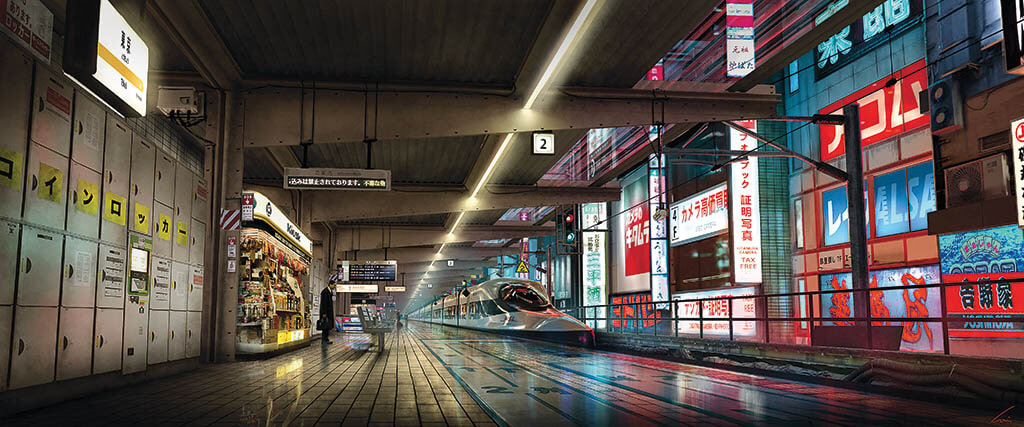
Neon signage illuminates the platform situated at Tokyo Station.
Visual effects enable Leitch to push the envelope of creativity. “In this movie particularly, the LED screens were a no-brainer,” he says. “That technology allowed us to do things that reduced post time and gave us way more flexibility in post. It was a lot of upfront prep to get the plates ready, but the interactive experience with the actors would have been hard to replicate any other way.” The LED screens assisted with the travel restrictions caused by the pandemic. “We shot the majority of the film on a stage, and we were not able to go to Japan at all for the film,” Brazelton states. “All Japan plates for the LED walls and establishing shots were supervised remotely.” The LED walls were the biggest technical challenge. “We needed to shoot and stitch footage in a short schedule.” Brazelton adds. “We also had some full CG builds that DNEG [led by Daniel Paulsson] and MR. X [led by Jessica Norman] had to deliver on a tight schedule. I worked closely with DP Jonathan Sella and key grip Mark Hyde to get the right footage on the screens at the right time. So many things need to be right, like color, horizon line and timing.”

One of the stops along the way is Yokohama Station.
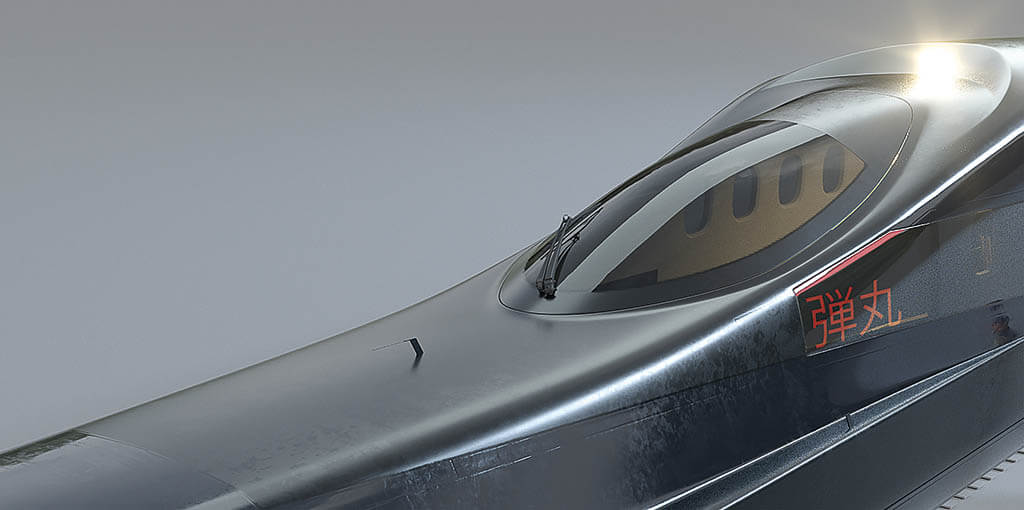
The bullet train was constructed based on scans and photography of a real train.

A nighttime view of the bullet train, which was treated as a character in its own right.
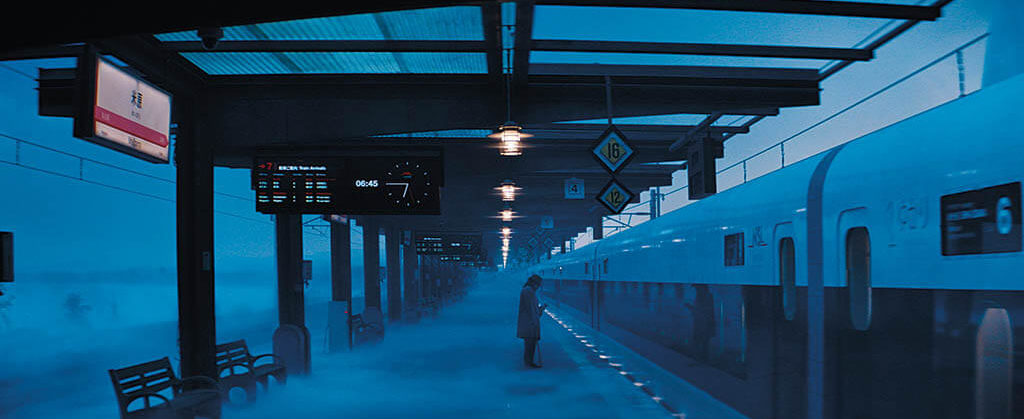
One station was dressed with different architecture to represent seven stations.

The driver car was placed on a pneumatic rig created by the special effects team led by J.D. Schwalm.
Over a period of 14 months DNEG produced 1,100 shots under the leadership of Visual Effects Supervisor Stephen James and Digital Effects Supervisor Rhys Salcome. “[Production Designer] David Scheunemann and his team designed the train cars and provided our visual effects team with the models,” states Brazelton. “We replicated them in 3D based on scans and photography of the real train that was built. David and I worked together closely to design the trainline platforms and the worlds around them.” Nighttime train scenes were captured with LED screens while daytime was shot on bluescreen. “We then filled in 3D environments for the bluescreen portion,” Brazelton continues. “All the train platforms were shot on bluescreen which we filled in later with 3D environments.” Bullet and sword hits were digitally created. “If someone is shot,” he notes, “we would shoot the action of it clean. Then the bullet hole hits and blood would be applied by makeup or set decoration for the aftermath of it. This gave visual effects something to work into and supported continuity in the film.”
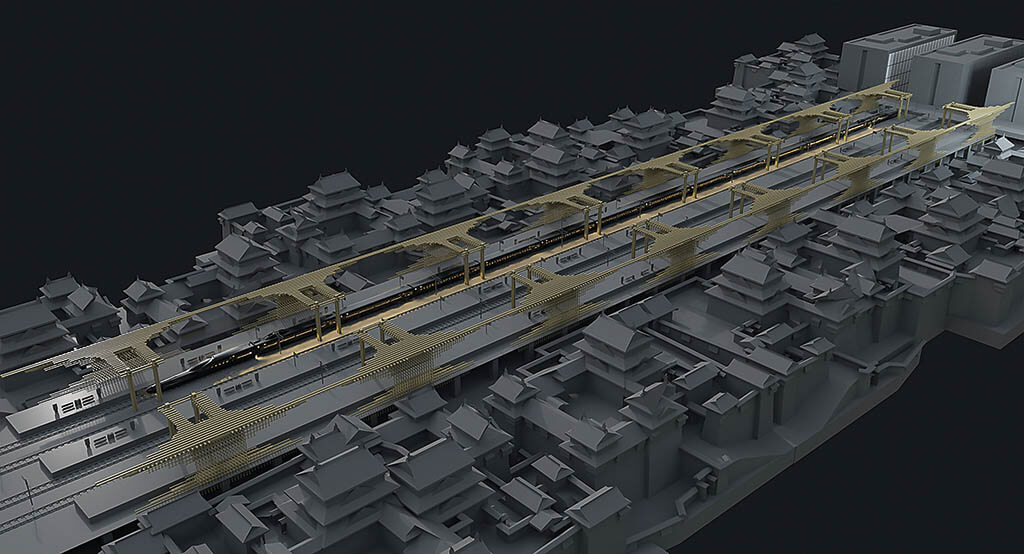
Visualizing the size and scale of the bullet train within the various environments.
Certain shots required digital doubles as well as face and limb replacements. “Stunts often give us the launching and landing points while we fill in the middle,” Brazelton observes. “We had to cheat the speed and just accept that whatever looked good for the shot was what it was. If it meant going 100mph when the train should have been going 300, it was okay.” Making things difficult was the global visual effects shortage during the height of the pandemic. “Films were being pushed six months at a time which made it impossible for vendors to plan for all the shows in production,” Brazelton says. “I was lucky to have an amazing [VFX] producer [Whitney Richman] and production team for this film. I could not have done this film without such a brilliant team around me.”
In reality, the train only consisted of three cars that were redressed. “Special effects and the art department put those cars together in different configurations,” Leitch reveals. “We had a puzzle map of how they could be put together to make it feel like we’re on a different part of the train. Then there was one station that got dressed with different architecture to represent seven stations, and pulling into that station we had the driver car on a pneumatic rig so we could bring it in only two lengths of that car, maybe 150 feet of that.” The train cars were built on top of a steel chassis. “They were approximately 21 feet long by 10 feet wide,” Schwalm remarks. “Each chassis was equipped with wheels, and a system was put in place to allow us to tow them in and out of the sound stages. Once in place on the stage the steel chassis could be bolted together to make up the long train cars.”

None of the scenes actually take place in Japan because of travel restrictions caused by the pandemic.
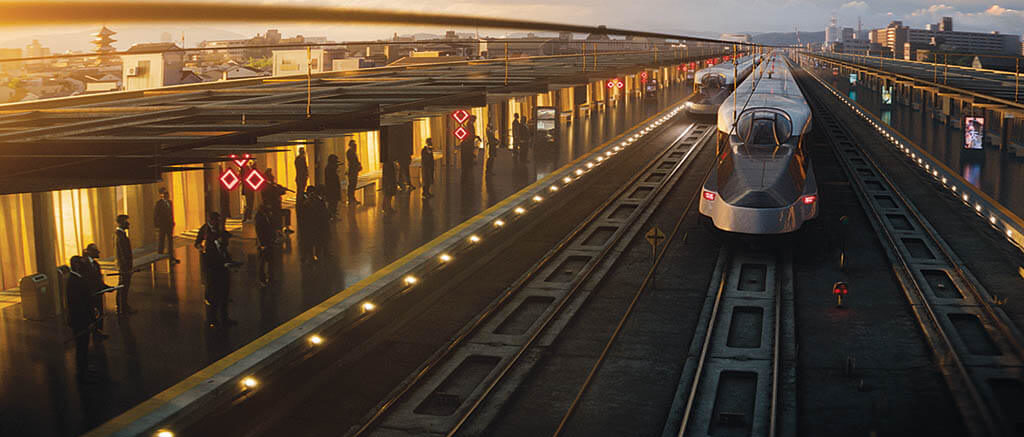
The visual language is homage to the pop sensibilities of anime.

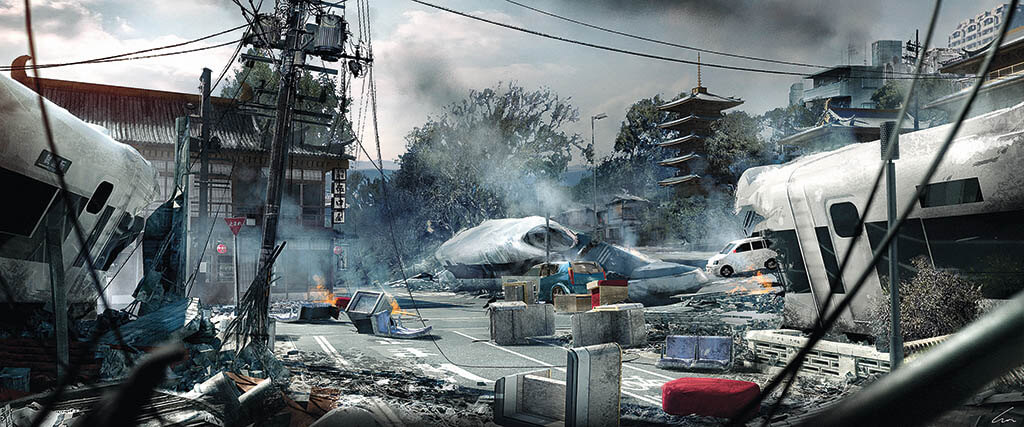
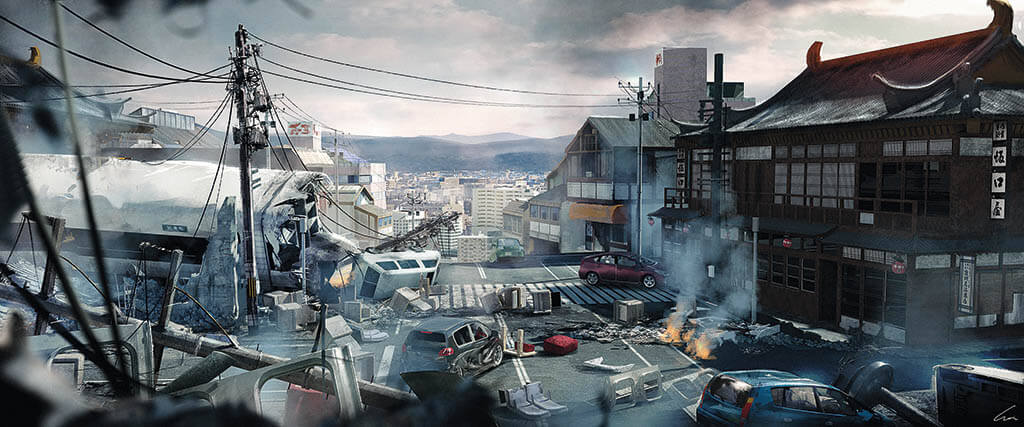
Conceptualizing what a crash site would look like for the movie.

Production Designer David Scheunemann and his team designed the train cars and provided the visual effects team, led by Michael Brazelton, with the models.
“When we were ready to move the trains around on stage for a shot, they were lifted on air bearings, which essentially floated the entire train on a very thin cushion of air,” Schwalm continues. “This allowed us to move the train back and forth with little rolling resistance. We used twin 400 horsepower servo motors connected to a large steel winch drum. This system would motivate the train forwards and backwards using 1¼ inch synthetic cables. It took approximately 30,000 pounds of pulling force from our winch to get the train up to 20 feet per second in the short distance provided on set.” The special effects team helped to create the illusion that the bullet train was moving at a high speed. Adds Schwalm, “To simulate the high-speed movement on the train we would leave the air bearings inflated and utilize pneumatic air cylinders to shake the train back and forth ever so lightly. The LED wall took care of the lighting effects.”
Hundreds of breakaways were constructed. “We also had to fabricate items that appeared to be rigid, as if made from metal or wood, but that were made from foam covered in vinyl images,” Schwalm reveals. “We used hundreds of bullet hits and squibs along with car flippers, motorcycle rigs, car cannons and explosions.” The biggest challenge was being able to move the train within a restrictive space. “I’m looking forward to seeing the train pull in or out of the station for the first time in the movie,” Schwalm comments. “I’m sure that will bring a smile to my face. Also, this was the last project I was able to collaborate on with my father, Jim Schwalm, before his retirement. Having him around on set, with his eyes overlooking our work, is priceless.”
COVID-19 restrictions caused Elísabet Ronaldsdóttir to edit Bullet Train at home in Iceland from February 2021 to June 2021. “When I came to Los Angeles, I moved in with David and producer Kelly McCormick, creating our own bubble,” Ronaldsdóttir says. “We locked edit in December 2021, and I went back home as we finalized visual effects and music. Then I went back to Los Angeles in April 2022 for the final mix.” Ronaldsdóttir embraces visual effects. “We worked closely with Mike Brazelton and Whitney Richman [VFX Producer],” she explains. “In addition, our Visual Effects Editor, Mike Fay, had an important role in our communication from the beginning. We managed the [editorial turnover for the visual effects team] with good planning and open and regular communication. Also, with Resilio [file sync software] in place, I did not have to manage any turnovers myself, as both Nick [Ellsberg, First Assistant Editor] and Mike had direct access to my work, even when I was working from a different continent.”
A primarily two-camera setup captured about 200 hours of footage with the final runtime, not counting end credits, being just under two hours. “A good action sequence demands that producers understand the importance of hard training, and understanding where to put the camera. My task is just to try not to mess it up. The biggest difference [compared to our previous collaborations] was the ensemble cast and various storylines within the film itself. It was a complicated task to try to balance multiple characters and keep the story intense, as well as the pace, while allowing the film to stay a wild creature,” Ronaldsdóttir says.
One of Leitch’s favorite scenes is the unveiling of the backstory of Wolf, portrayed by Bad Bunny, which humanizes his irredeemable character. “For three minutes, with only music, you see him lose his mother, to the time he becomes a hitman for the cartel, to the time he falls in love and gets married, to the time he meets Ladybug, Brad’s character – it’s fun and an interesting piece of cinema. I fought hard to keep it in the movie and it really delivers.” Even a water bottle is connected by fate to the other characters and has its own story. “We wanted to do this compelling POV shot which involved creating a doggy cam for the water bottle itself,” Leitch says. “Special effects assisted [by producing a soft bottle or proxies that visual effects could augment digitally]. Visual effects also altered frames where we needed to replace ceilings. We were shooting on a crazy fisheye lens. That was a good collaboration from all departments.”